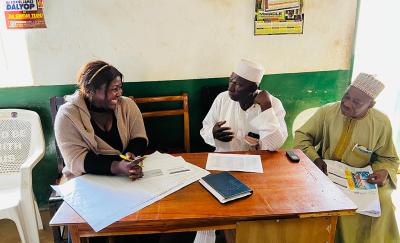Quality Improvement: A Health System Strengthening Priority


Malaria. Ebola. Maternal and child morbidity and mortality. Malnutrition. Tuberculosis. Reproductive health. Family planning. Water, sanitation, and hygiene.
You name it, and the Democratic Republic of Congo (DRC) faces such challenges to improved health outcomes, aggravated by years of civil strife and corruption. That’s why the U.S. Agency for International Development (USAID) Abt-led Local Health System Sustainability (LHSS) Project and Integrated Health Program (IHP) worked with the DRC Ministry of Health to improve the quality and volume of health services by, among other things, strengthening public financial management and reducing barriers to care.
And the results of work at the central, provincial, and health-zone levels showed the benefit of quality improvement efforts. Under LHSS, health department training of community health workers in one rural district to raise parents’ awareness of symptoms led to an increase of visits by children to primary health care facilities from 40 a month to 500 in a few days. Under IHP:
- 7.1 million newborns received care in health facilities within three days of birth
- 7 million children under 12 months received three doses of the pentavalent vaccine for common childhood diseases
- Families received 7.9 million insecticide-treated bednets to combat malaria (the DRC has the second highest number of cases in the world)
- 26.7 million children benefitted from nutrition programming and assistance
- The DRC had a 93.2% therapeutic success rate for 322,294 people with pulmonary tuberculosis.


Health systems strengthening: a global health care challenge
The DRC is hardly alone. Health systems in many developing countries grapple with numerous complex challenges, from a broad array of diseases, escalating care costs, and decentralized management structures to inequitable health, regulatory obstacles, and a shortage of healthcare professionals. These challenges transcend the care an individual provider or facility offers but affect that care. They underscore the need for efficient organizational structures and processes to govern, manage, and finance health systems effectively.
Quality improvement (QI) principles can serve as a cornerstone in addressing these larger issues. Combined with a culture that prizes data-driven decision-making, QI offers a robust framework to eradicate inefficiencies in organizational systems and processes. That, in turn, improves system performance and, as the DRC shows, can contribute to better health outcomes for patients.
Quality in a health system encompasses several dimensions, including safety, effectiveness, efficiency, timeliness, patient-centricity, integration, and equity. They should be part of every facet of a health system, from roles and rules to relationships. Poor quality measures and standards threaten patients by, for example, creating unnecessary administrative burdens that can compromise access to treatment and thus patient well-being. Administrative obstacles range from discrimination to the need to navigate multiple facilities for required services.
Understanding Quality Improvement Principles
When health system actors follow quality principles, their understanding of the system enables them to take ownership for solving problems. The core principles of quality improvement and the iterative, data-driven methodology to implement them apply across sectors. The principles include:
- a commitment to understanding the system
- identifying bottlenecks
- testing changes to processes to improve system functions
- measuring changes and using data to track progress
- engaging a broad group of stakeholders
- fostering a culture of continuous learning
- sharing knowledge with a focus on client needs, values, and preferences.
Traditionally, QI initiatives in health focus on improving service delivery processes at the point of care: a clinic, hospital, or doctor’s office. The aim is to curtail human errors, enhance service quality, and improve patient-centered outcomes and satisfaction. This approach ensures that a health facility's performance aligns with a nation's broader health objectives. But if the facility lacks needed equipment because of a lack of funds or supply chain issues, the facility can’t provide quality care.
What’s more, the focus on facilities fails to recognize that versatile QI methods apply to critical organizational functions within a health system. For instance, within human resources, performance appraisal and feedback systems provide employees with a structured platform for growth and development. Regular assessments and constructive feedback foster a culture of continuous learning, enabling employees to voice concerns and identify potential avenues for improvement. These methods also find applicability in inventory and resource management systems, budgeting and financial analysis, patient flow information technology systems, regulatory audits, and policy reviews.
Challenges and Opportunities in Implementing Quality Improvement
While the potential benefits of quality improvement methods are profound, implementing them within health system management structures faces challenges. Overcoming entrenched top-down management styles in favor of collaborative approaches requires cultural shifts—a significant hurdle. Additionally, fostering a culture of continuous improvement and curiosity requires a departure from the traditional "blame culture" that often pervades health systems in developing countries. Additional challenges include issues related to data quality and accessibility, interoperable health information systems, resource constraints (including time, human, and financial), and the lack of effective communication and collaboration among various health system actors.
Abt Global: Exemplifying Success through Quality Improvement
Integrating quality improvement into health systems management processes and interventions shows the transformative potential of these principles. Abt’s projects exemplify the possibilities when QI principles are infused throughout health systems. Rooted in data-driven decision-making and a culture of improvement, QI offers a robust framework to address the complexities of modern health systems. Below we provide a few examples that serve as beacons of what is possible.
IHP addresses maternal mortality in the DRC.
Even after an 18 percent decline between 2000 and 2020, the DRC still ranked 11th in the world in maternal mortality rates. Recognizing the urgency of addressing this longstanding problem, country leaders identified the enhancement of health systems quality as a pivotal solution. This strategic decision aimed to tackle the root causes of maternal mortality, underscoring the vital role that improved health systems play in safeguarding the well-being of women during childbirth.
To enhance health systems quality, the DRC IHP project embarked on a transformative journey by strategically integrating quality improvement approaches into health system operations. The project initially focused on key activities such as clinical mentoring and integrated supervision. However, recognizing that these alone could not address quality challenges, the project collaborated with the Ministry of Health and partners to consolidate various quality improvement approaches into an integrated framework. This holistic framework went beyond clinical care, encompassing broader health system elements such as medications, data, equipment, infrastructure, and more.
Three pivotal tools formed the cornerstone of IHP’s efforts: Participatory Institutional Capacity and Learning Assessment (PICAL) to assess organizational, administrative, and institutional capacities; Community Performance Bulletin (BCP) to foster community engagement and accountability and track progress around health areas to inform decision making; and Integrated Quality Approach (DQI) to track services quality and improvement to inform improvement plans, policy formulation, and national health strategies.


Abt’s Health Systems Approach
After conducting two rounds of PICAL evaluation in nine provinces, a demonstrated improvement exceeded 20% in 21 of the 33 sub-areas assessed, particularly planning, inclusion, communication, and participation. Furthermore, IHP supported 20 facilities in implementing the DQI process and increased 5 out of 6 pillars' score from 56% to 70% in one year. That included Infrastructure and materials, drugs, human resources, governance leadership, services delivery, and HMIS. These changes are expected to reduce maternal deaths over time.
The efforts have produced significant achievements: decentralization of responsibilities at the provincial health directorate level and ensuring clearer roles and responsibilities for departmental leaders. The project facilitated a more transparent sharing of management information and budgets within the provincial health directorate, fostering increased trust and mutual accountability among departmental leaders. Notably, the project contributed to a better understanding of approved roles and responsibilities at the national level for both provincial health directorates and health zones, promoting more effective governance.
What’s more, the community demonstrated motivation and engagement, actively supporting access to healthcare through direct contributions, such as improving infrastructure, hygiene in health centers, water supply, and security measures. Active participation of provincial partners in addressing health challenges and improved coordination among stakeholders in provinces showcased successful collaboration and resource pooling for shared investments in healthcare.
Quality Improvement in Health System Management for Enhanced Family Planning Services in Mozambique
Through the Improved Family Planning Initiative (IFPI) project in Mozambique, Abt collaborated on strengthening health systems in three provinces. With a primary goal of increasing the use of voluntary family planning services, Abt has focused on enhancing leadership and commitment to support the national family planning program at various health system levels. Working with government stakeholders, Abt introduced the Management Standards Compliance (MSC) tool, which includes both district health management and health facility quality improvement components.
At the district level, health managers engaged in self-assessment in key areas, including monitoring and evaluation, planning, budgeting, and supply chain. A pivotal aspect of this approach involved employing the Plan-Do-Study-Act (PDSA) cycle to develop post-assessment quality improvement plans to address identified gaps. Between 2021 and 2023, 41 districts’ compliance with MSC standards soared from an average of 62 percent to 85 percent.
The tool's effectiveness led to its adoption by the Mozambique Ministry of Health. It’s now integrated into the annual planning, budgeting, and quality improvement processes, with plans underway for national expansion and scaling. This case exemplifies the transformative impact of quality improvement methods in elevating health system management performance and ensuring sustained progress in family planning services.


Implemented Scorecard: Strengthening the Quality Improvement (QI) process in primary health care facilities
In Nigeria, the Basic Health Care Provision Fund (BHCPF) is a health financing initiative to enhance the quality of care for the poor in selected primary health care facilities. The BHCPF uses a QI process that incorporates quarterly quality assessments and business plan development. The BHCPH facility assessment scorecard is a tool used to monitor the progress of facility quality improvement and to inform the development of a quarterly business plan, which serves as the guide for quality improvement-related expenditures.
With support from the LHSS project, the BHCPF's data collection for quality assessments has transitioned to a mobile phone application, streamlining processes to increase data timeliness and accuracy. This collaborative effort, spanning Plateau, Zamfara, and Nasarawa States, aligns with the LHSS project's broader objective of strengthening health systems to achieve universal health coverage (UHC). The project focuses on reducing financial barriers, increasing health coverage for low-income households, and improving the quality of essential health services.
The BHCPF's QI process linking quality of care to financials through a structured approach encompassing quality assessments, business plan development, and financial reporting is innovative and promising. Challenges with the scorecard, including variations in assessors' measurement interpretations and the need for benchmarking for clinical service utilization, underscore the importance of continuous process refinement.
Nonetheless, strengthened use of this process at the facility, local government, and state level can significantly improve quality and value for money for direct facility financing– a critical outcome given the current BHCPF reform being undertaken by the new administration that will lead to increased funding to facilities. For example, in Nasarawa State, quality assessment covered 147 BHCPF facilities with a 100% completion rate and improvements in financial systems management metrics from 73 to 87% over six months.
Applying QI methods to strengthen health systems operations and performance represents a relatively new frontier and has not been extensively tested. If the benefits approach those at the services level, they could be profound. As more governments adopt QI methods, it will be critical to evaluate their performance to assess whether they live up to their promise. Any assessment is likely to detect gaps. At that point, it may be time to use QI methods on the QI approach itself.
We wish to acknowledge the important contributions of our colleagues on the DRC IHP, Nigeria LHSS, and Mozambique IFPI teams.
Read More

Pathways to UHC: Nigeria’s State and Local Approaches to Financing Integrated HIV Services and Primary Health Care
Nigeria’s state and local government-driven approaches to integrated primary health care are transforming financial protection and access for vulnerable populations, setting a replicable model for sustainable universal health coverage.

Local Digital Innovation Improves Family Planning in Uganda
An LHSS grant helped a Ugandan pharmacy expand an e-Pharmacy platform to include more family planning (FP) products and train staff to provide FP counseling.

Global Health - June 2024
Stay informed with Abt's Global Health Newsletter for the latest in health systems strengthening and more.


